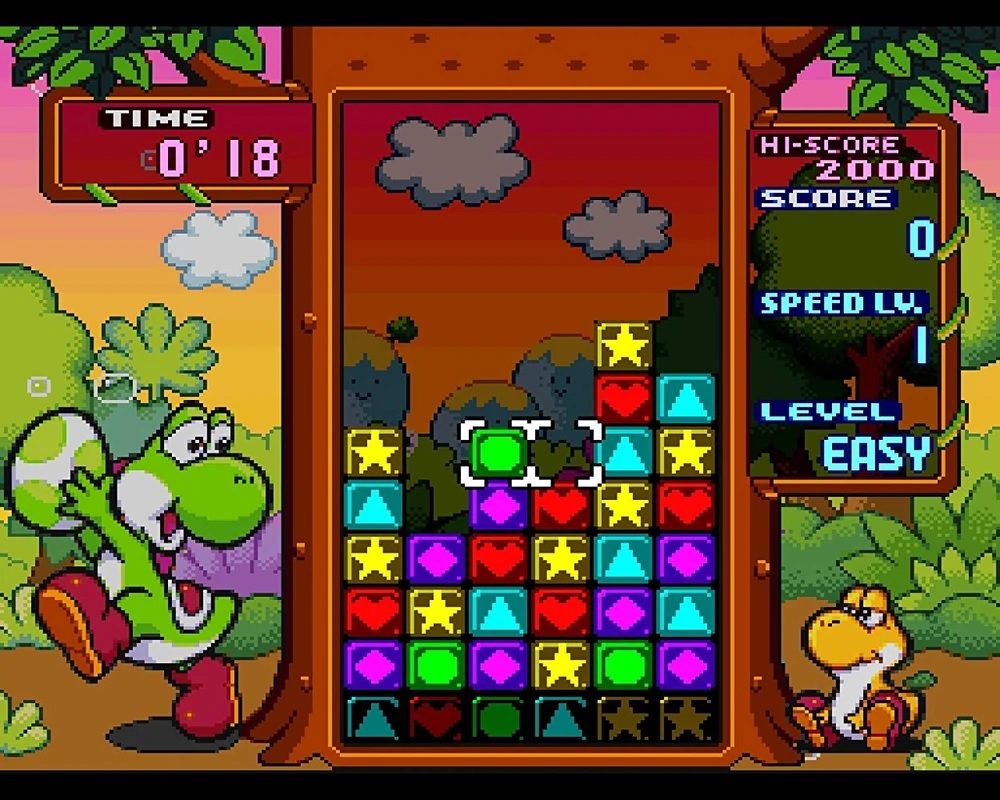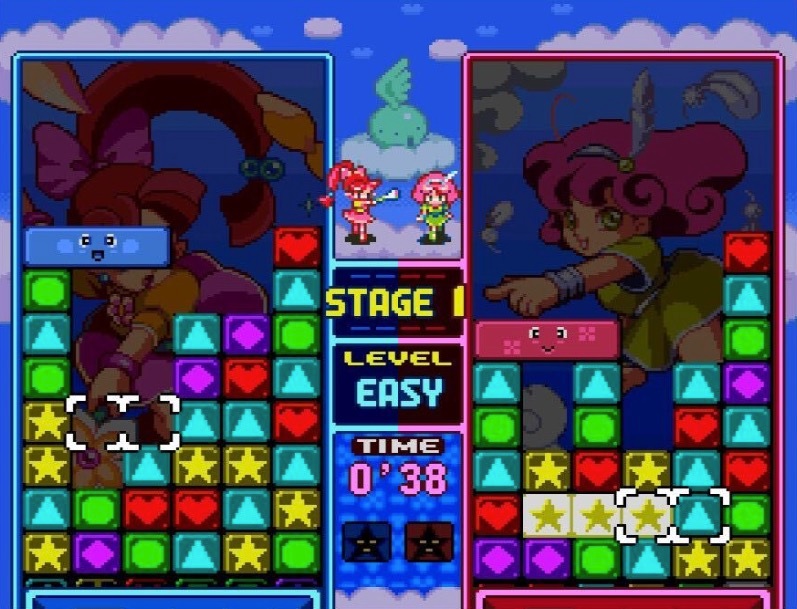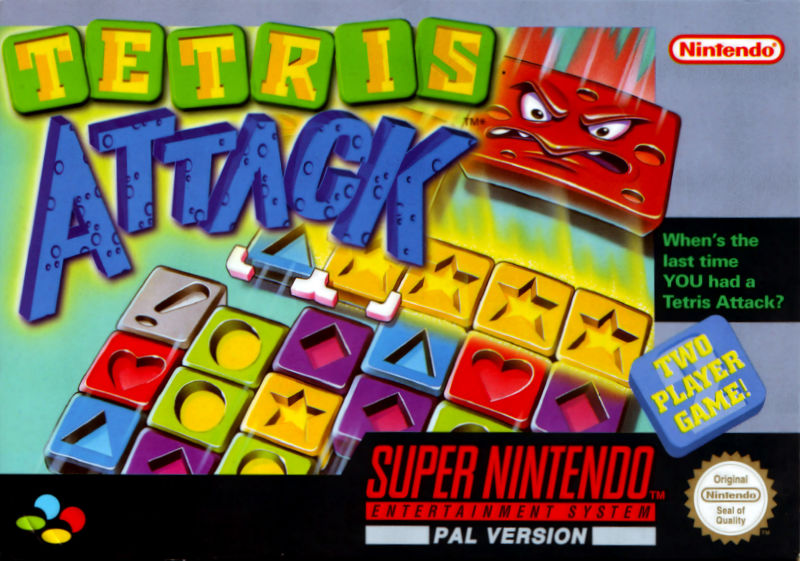As a Tetris fan, I looked towards talking about predecessors of Tetris for my retro review. Lo and behold, the Crerar library had Tetris Attack for the SNES as part of its game collection. I thought it was the perfect opportunity to see firsthand how exactly the illustrious Tetris franchise evolved across decades and across different platforms. However, much to my surprise and initial disappointment, Tetris Attack is a very different game from the original Tetris.
What is Tetris?
Firstly we have to discuss the history of Tetris before talking about Tetris Attack. Tetris is a real-time puzzle game created by Alexey Pajitnov in 1984. One of seven different “tetrominos” will fall from the top of the board, and it is the player’s job to arrange the pieces such that they don’t build all the way up to the top. This is done through the line clear mechanic, whereby any rows of blocks that are completely filled are cleared from the board, and any blocks above are shifted down to fill the empty space.
I’m sure the explanation above was largely unnecessary, since Tetris is almost certainly the most popular game ever created. As of October 2010, Tetris has been ported to 65 platforms, which was over a decade ago. This doesn’t include my roommate’s Amazon Fire TV, which was released in 2014, or any new-ish generation consoles like the Nintendo Switch, or the Playstation 4. As of April 2014, Tetris has 425 million paid downloads on mobile devices, which doesn’t include any console versions, or any free-to-play versions. To put this into context, Minecraft, which is also widely considered to be the most popular video game, has sold over 238 million copies, as of now, 7 years later. Tetris is such a cultural icon that there is a psychological phenomenon named after it, called the Tetris effect. This phenomenon is characterized by people’s experiences playing Tetris, where after extended periods of time, they would start to see mundane objects as Tetris pieces, and attempt to spatially reason arrangements of said objects.
So then what is Tetris Attack?
Tetris Attack, similarly to Tetris, is a real-time tile-clearing puzzle game released by Nintendo in 1995. This is pretty much the extent of the similarity between the two games. The gameplay of Tetris Attack is a lot closer to something like Candy Crush Saga as opposed to Tetris in that the game is played by clearing rows, columns, or intersections of at least 3 continuous blocks of the same color instead of rows spanning the entire board. Unlike in Tetris where the blocks fall from the top over an empty board, the blocks are already on the board and the player’s job is not to place more blocks but rather to rearrange the ones already there. There is a cursor on the screen that outlines two blocks horizontally adjacent from each other, and the player is allowed to swap the two blocks inside the outlines with each other.

Something else to consider about Tetris Attack is its overall presentation. Tetris games for the most part lack a tangible narrative; there are blocks and they have to be arranged, that’s the whole narrative. There are Tetris games that feature characters, but in general, there is no consistent story behind who is part of Tetris, or why blocks are falling in the first place. In contrast, Tetris Attack contains a very clear narrative in its single-player main story, which features characters from Super Mario World 2: Yoshi’s Island. Yoshi’s friends are cursed by Bowser, and Yoshi has to free all of them from curses by playing Tetris Attack against increasingly hard CPU players, with the final 3 encounters being 2 of Bowser’s minions and Bowser himself.
So this is clearly a Tetris game in name only. Interestingly, the Japan-only release of Tetris Attack was called Panel de Pon, and instead of the characters being from Yoshi’s Island, they are fairies from a previously unestablished universe. This title has no mention of Tetris at all. So why does the version that explicitly references Tetris have Yoshi in it?

How Tetris Attack Came to Be
Yoshi’s Island released on the SNES about 10 months before the release of Tetris Attack to wide praise, and is notably the first game to feature Yoshi as the main character. As established previously, Tetris was and still is a cultural phenomenon. Considering this, what is the best way for Nintendo to market their new Yoshi game to wider audiences? Their answer was to take this obscure Tetris-like called Panel de Pon, and alter video game history forever by branding it as a Tetris game. In an interview with Alexey Pajitnov and Henk Rogers, the founders of the Tetris Company, they reveal that shortly after founding the company, they were approached by Nintendo about using the Tetris name to release an international version of Panel de Pon.
“When Nintendo came to us, and said ‘we would like to take this Japanese game called Panel de Pon, and rename it Tetris Attack,’ I’m saying, ‘it’s not Tetris.’ But my partner’s saying ‘but it is money!’ So, uhhhh, so, we, I, reluctantly agreed.” – Henk Rogers
Tetris Attack exists not as a natural extension of the Tetris franchise, but rather as a corporate marketing scheme to market the newest release of the Mario franchise by capitalizing on the hype created by the Tetris franchise. As a game with unique mechanics, its name and aesthetics were heavily influenced by the games surrounding it.
“It should have had its own name. It kind of got lost in history cause it got the name Tetris, but it’s not Tetris. It could have, it should have stood up on its own two feet. That’s how I feel about games in general.” – Henk Rogers
In the 4 hours I spent in the Retro Corner of the MADD Center, I had a lot of fun with this game. So thankfully, contrary to what the quote implies, Tetris Attack managed to survive against all expectations of its false identity through the Puzzle League franchise, which although less popular, is now both functionally and legally distinct from Tetris. The franchise is small, and has done a few crossovers with much more notable franchises such as Pokemon Puzzle League for the N64, and more recently Animal Crossing Puzzle League for the 3DS.
Sources:
“About Tetris®.” Tetris, https://tetris.com/about-us.
Perlee, Ben. “Interview with Alexey Pajitnov and Henk Rogers on Tetris.” Destructoid, 8 June 2009, https://www.destructoid.com/interview-with-alexey-pajitnov-and-henk-rogers-on-tetris/.
Reilly, Luke. “Tetris Has Reached 425 Million Paid Mobile Downloads.” IGN, IGN, 8 Apr. 2014, https://www.ign.com/articles/2014/04/08/tetris-has-reached-425-million-paid-mobile-downloads.
Thomas, Lucas M. “Yoshi: Evolution of a Dinosaur.” IGN, IGN, 8 May 2012, https://www.ign.com/articles/2010/05/24/yoshi-evolution-of-a-dinosaur.
Winslow, Jeremy. “Minecraft Reached 140 Million Monthly Users and Generated over $350 Million to Date.” GameSpot, Gamespot, 3 May 2021, https://www.gamespot.com/articles/minecraft-reached-140-million-monthly-users-and-generated-over-350-million-to-date/1100-6490962/.


Quite the informative article. I like your style, it feels like an NPR report.
If anyone reading this wants to go down another Tetris rabbit hole, I would like to inform them that Tetris has official sequels (two of which are by the original creator) with different gameplay than Tetris, including Hatris, Welltris, and (putting this in quotes verbatim) “Faces…tris III”, the 4th in the series.